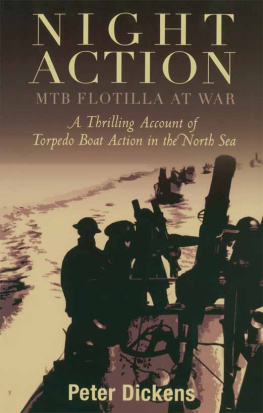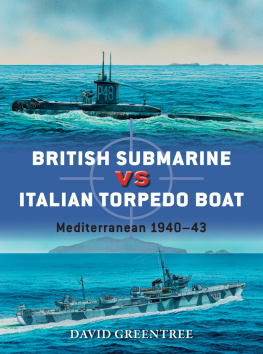The Author
Captain Peter Dickens DSO, MBE, DSC was the son
of Admiral Sir Gerald Dickens and the great-grandson of
Charles Dickens. At the outbreak of war in 1939 he had just been
promoted lieutenant, and before becoming Senior Officer of 21st
MTB Flotilla saw service in Norway and on East Coast convoys.
Command of HMS Blencathra at the end of the War
was followed in peacetime by command of three destroyers.
He was for many years President of the
Coastal Forces Association. He died in 1987.
NIGHT ACTION
MTB Flotilla at War
Peter Dickens
Introduction by Trevor Robotham
Vessels large must keep near shore
But little boats may venture more.
To all who fought with the 21st MTB Flotilla,
and to the dead and wounded of both sides
Copyright Peter Dickens 1974
Introduction Copyright Trevor Robotham
This edition first published in Great Britain in 2008 by
Seaforth Publishing,
Pen & Sword Books Ltd,
47 Church Street,
Barnsley S70 2AS
www.seaforthpublishing.com
British Library Cataloguing in Publication Data
A catalogue record for this book is available from the British Library
ISBN 978 1 84832 012 3
First published by Peter Davies, London, 1974
All rights reserved. No part of this publication may be reproduced
or transmitted in any form or by any means, electronic or mechanical,
including photocopying, recording, or any information storage
and retrieval system, without prior permission in writing of both
the copyright owner and the above publisher.
The right of Peter Dickens to be identified as the author of this work
has been asserted by him in accordance with the
Copyright, Designs and Patents Act 1988.
Printed and bound in Great Britain by Creative Print & Design, Blaina.
Contents
I N THIS BOOK Peter Dickens presents a remarkably vivid and engrossing account of Coastal Forces operations off the wartime East Coast of England and as far as enemy occupied shores. His story is told with humour and, in the authors own words, with accuracy and ungilded truth. As such it presents a quite unrivalled insight into the courage and bravery of young men, largely untrained and tested in this method of warfare in the early part of the War, seeking and engaging the enemy with the minimum of protection in their lightly armed wooden craft. Accounts of engagements with the enemy are given in remarkable detail and show a clear insight into the need for those in command to make life and death decisions in the thick of war.
Although developed to a small extent in World War I with the use of Coastal Motor Boats, the disciplines of this area of warfare were much neglected in the interwar years. In 1939 the Motor Gunboats and Motor Torpedo Boats available for the tasks ahead of them were totally inadequate and were increased in number dramatically as Their big ship oriented Lordships, to quote the author, came to a realisation of the need for the protection of our coastal convoys and coastal waters from enemy attack. Much of the credit for the development of Coastal Forces can be given to those few specialist ship builders whose vision appeared to exceed that of the Admiralty. This was an area of warfare that was largely uncharted and, with innovation and the intelligent development of procedures, new disciplines of warfare were founded. Peter Dickens was part of this world and as a young Lieutenant, with only limited operational experience, he nevertheless brought to this scene a great sense of purpose and his ultimate contribution to Coastal Forces wartime operations was immense. He quickly saw the folly of racing into the enemy with all guns blazing, which was an approach which sat well with those then commanding Coastal Forces operations from ashore, but which did little but alert the enemy to the Royal Navys presence. He developed techniques of stealth, which in addition to bringing surprise to the enemy, gave the benefit of being able more carefully to assess the opposition and the potential targets. His torpedo attacks became increasingly successful and his ability and reputation as a wartime Coastal Forces leader developed in parallel. The conditions of this close action ship-to-ship warfare are brought out clearly but the attrition from adverse weather on open bridges, the constant high volume of noise from the engines and the ever straining of all senses as they tried to detect the enemy, must have produced human deterioration which is difficult to imagine. The small ships companies bonded and were totally dependent on each others professional skill. Peter Dickens writes of his respect and admiration for the legendary Robert Hichens, who commanded the Motor Gunboat Flotilla and with whom he worked to great effect, both at sea and in lobbying the Admiralty for improvements in weapons and sensors.
The author had numerous encounters with the enemy and fought fifteen significant actions firing fifty-five torpedoes and gaining at least a dozen hits leading to either a sinking or severe damage. He gained first his Distinguished Service Cross for attacks on enemy shipping in September and November 1942 and his Distinguished Service Order (DSO) for a particularly daring attack on enemy shipping off the Dutch Coast on 13 July 1943. These accompanied a Mention in Despatches in early 1943.
Any autobiography or personal account will inevitably tell the reader a lot about the personality and character of the author and this book is no exception. Joining Coastal Forces in 1942 put him, as a career Royal Naval officer, in a slightly unusual position. Although Coastal Forces, in the early war years, had been mainly manned by career officers with his background, these had largely given way to officers of the Royal Naval Volunteer Reserve. These were officers in the service for the duration of hostilities and from a wide and vastly different range of backgrounds from that of the Dartmouth trained career officer. This must have produced tensions, which although not always clear in the book, were known to exist. Nevertheless, both this book and other accounts confirm the mutual respect that quickly developed between the two factions of service officers. Ambition and eagerness for command are not surprising characteristics in a 25-year-old naval officer on the threshold of his career and Peter Dickens had these characteristics in abundance. Once he had achieved his command of the 21st MTB Flotilla he started to demonstrate qualities of leadership and the ability to assess people and situations with remarkable clarity, which undoubtedly helped him gain confidence in his role. Nevertheless, he is candid about the fears and self doubt which haunt all commanders who are faced with putting the lives of others in danger. He made mistakes but manages to put these into perspective with humour and self-depreciation. What is particularly revealing is his genuine concern and respect both for each member of his crew and also for others working with him within the flotilla.
This is a fascinating account that will undoubtedly lead readers to learn more about the Coastal Forces of World War II and the men it moulded. Most particularly, the book confirms the wisdom of giving young men responsibility early in life and making them responsible and accountable for their actions.
Captain Trevor Robotham RN
Director of the Coastal Forces Heritage Trust











